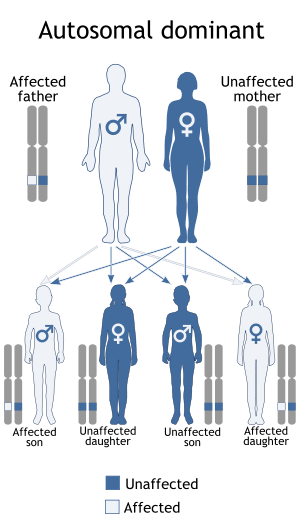Pachyonychia congenita
| Pachyonychia congenita | |
|---|---|
| Classification and external resources | |
| Specialty | medical genetics |
| ICD-10 | Q84.5 (ILDS Q84.520), (ILDS Q84.530) |
| ICD-9-CM | 703.8 757.5 |
| OMIM | 167210 167200, 167210 |
| DiseasesDB | 32826 |
| eMedicine | derm/812 |
| MeSH | D009264 |
Pachyonychia congenita is an autosomal dominant skin disorder.
Classification
Pachyonychia congenita may be divided into these types:[1]:510
- Pachyonychia congenita type I (also known as "Jadassohn–Lewandowsky syndrome"[2]) is an autosomal dominant keratoderma that principally involves the plantar surfaces, but also with nails changes that may be evident at birth, but more commonly develop within the first few months of life.[1]:510[2][3]:569
- Pachyonychia congenita type II (also known as "Jackson–Lawler pachyonychia congenita" and "Jackson–Sertoli syndrome") is an autosomal dominant keratoderma presenting with a limited focal plantar keratoderma that may be very minor, with nails changes that may be evident at birth, but more commonly develop within the first few months of life.[1][3]:569
Signs and symptoms
Common symptoms include:
- Excess keratin in nail beds and thickening of the nails
- Hyperkeratosis on hands and feet
- Oral lesions that look like thick white plaques
- Steatocystoma multiplex
- Pain
- Blisters
Pathophysiology
The condition is caused by genetic mutations in one of four genes that encode keratin proteins specific to the epithelial tissues affected in the two forms of the disorder. PC1 is caused by mutations in keratin 6A (protein name K6A; gene name KRT6A) or keratin 16 (protein K16; gene KRT16). The PC2 form is due to mutations in the genes encoding keratin 6B (protein name K6B; gene name KRT6B) or keratin 17 (protein K17; gene KRT17). Three of the genes causing PC were identified in 1995[4][5] with the fourth gene following in 1998.[6]
Inheritance

Pachyonychia congenita follows an autosomal dominant pattern of inheritance, which means the defective gene is located on an autosome, and only one copy of the gene is required to inherit the disorder from a parent who has the disorder. On average, 50% of the offspring of an affected person will inherit the disorder, regardless of gender.
Occasionally, however, a solitary case can emerge in a family with no prior history of the disorder due to the occurrence of a new mutation (often referred to as a sporadic or spontaneous mutation).
See also
References
- 1 2 3 Freedberg, et al. (2003). Fitzpatrick's Dermatology in General Medicine. (6th ed.). McGraw-Hill. ISBN 0-07-138076-0.
- 1 2 Rapini, Ronald P.; Bolognia, Jean L.; Jorizzo, Joseph L. (2007). Dermatology: 2-Volume Set. St. Louis: Mosby. p. 740. ISBN 1-4160-2999-0.
- 1 2 James, William; Berger, Timothy; Elston, Dirk (2005). Andrews' Diseases of the Skin: Clinical Dermatology. (10th ed.). Saunders. ISBN 0-7216-2921-0.
- ↑ McLean WH, Rugg EL, Lunny DP, et al. (1995). "Keratin 16 and keratin 17 mutations cause pachyonychia congenita". Nat. Genet. 9 (3): 273–278. doi:10.1038/ng0395-273. PMID 7539673.
- ↑ Bowden PE, Haley JL, Kansky A, Rothnagel JA, Jones DO, Turner RJ (1995). "Mutation of a type II keratin gene (K6a) in pachyonychia congenita". Nat. Genet. 10 (3): 363–365. doi:10.1038/ng0795-363. PMID 7545493.
- ↑ Smith FJ, Jonkman MF, van Goor H, et al. (1998). "A mutation in human keratin K6b produces a phenocopy of the K17 disorder pachyonychia congenita type 2". Hum. Mol. Genet. 7 (7): 1143–1148. doi:10.1093/hmg/7.7.1143. PMID 9618173.
External links
- GeneReviews/NCBI/NIH/UW entry on Pachyonychia Congenita
- PC Project webpage
- OMIM: 260130 Pachyonychia congenita recessive at NIH's Office of Rare Diseases